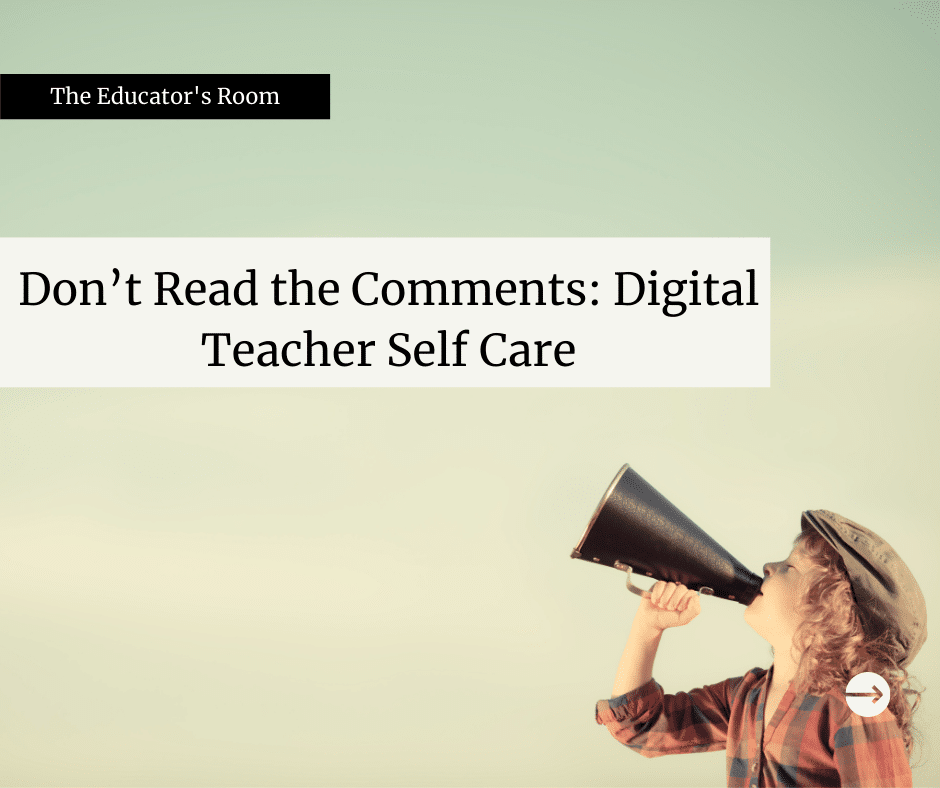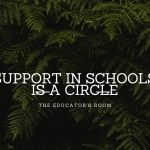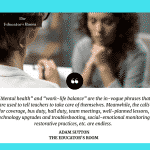Everyone knows you don’t read the comments on Twitter. An adorable video of a dog skateboarding can instantly turn sour when unleashed on the internet. Facebook lets users publish a staggering amount of misinformation, which is especially frightening in a contentious election season. And every teacher knows that, like Yelp reviews, students only evaluate in hyperbole. They tell you who was the best or worst teacher EVER. Rarely do they give you a blandly logical, “they were okay.”
I know all this, but, still, I made a rookie mistake.
I decided to read comments from a district survey sent to families and teachers this summer. It was one of those surveys where you read and rate comments so the surveyor can gather the major ideas that are surfacing.
Good in theory, terrible in reality when the prevailing theme was: “teachers aren’t doing their jobs.”
This is hard to read when, during a global pandemic, we are all doing our best, trying to keep our heads above water. Some of us haven’t seen our families in months because we’re doing our best to follow the mandates, even when it seems most people are disregarding science in favor of their personal preferences.
None of this teacher-directed negatively is new, but the blame feels dialed up to eleven.
Every teacher can recall times they’ve been told taxes pay their salary, summer’s off must be a dream, or they must be certifiable to choose to teach. In my district, we are two years out from a contentious strike where we were heckled, honked at, and generally made to feel like we were ungrateful for our jobs.
Now, we are somehow responsible for the failure to contain the COVID-19 pandemic, the limits of online learning, and, quite honestly, the choices some students make in simply not doing their schoolwork.
Either that, or we’ve collectively fallen prey to the hoax of this virus and its overinflated risk. (To all the biology, statistics, and government teachers out there, please, keep up your strength, we need you!)
It’s so much easier to blame the teacher than it is to realize that your kid is missing assignments because he spent the class period filming his teacher for TikTok. (Or so I’ve heard.)
The (Virtual) Reality
This spring, distance learning was ineffective and, as some survey comments attested, this fall needs to be better. And I agree, wholeheartedly. Spring was a mess because we were all in crisis mode. Literal, global pandemic level crisis mode.
So I’m trying to do “better” because I believe that what I do matters (and because I have a serious case of self-competition).
We are three weeks in and I am overwhelmed. Online learning is 10 times the work of in-person learning, with absolutely none of the reward. I am at my absolute physical and mental maximum. With chronic, debilitating migraines, by the end of most days, my head and eyes throb.
I spend hours creating instructional materials, videos, step-by-step instructions, schedules, and assignments. But,when I start class with 9 of 26 finished assignments, I honestly have no idea if my students even looked at any of it.
Teenagers not doing their work is not a novel phenomenon, but the difference is the amount of time and effort it takes for me to track those students down. What used to be a “hey, can I help you with that?” or, “yes, right there on page 3” is now digital crickets in a zoom classroom.
Best practices for distance-learning all profess that feedback needs to be timely, personal, and applicable. Without in-person communication, the only feedback I can really give effectively is written and, because our grind grading culture has trained students to care more about points than learning, it has to have numbers attached or they won’t even look.
This week, I tried to shift our live class time to be more productive, leaving plenty of space for questions where I’d hope we could learn together. Instead, during one live class, I’m bombarded with students from my other classes. The students I saw yesterday. The ones who said they would definitely finish the assignment later.
In the span of one period, while I was desperately trying to help my period 2 students engage (hand motions and private chat boxes and all), I received 57 emails with questions and late work notifications.
That’s not a random number, I counted.
One student, in particular, sent me five emails in a row saying essentially the same thing; “Can you grade this? Now???” I tried to ignore him and soldier on, but by the fifth “ding,” I finally asked him to please wait and I’d get to him as soon as I could.
I turned off my volume after that.
What Work Load?
When I see a student is missing six out of seven assignments, something is amiss. Unless I receive information to the contrary, that tells me they’re overwhelmed, drowning, or lost and I am just not there in the same way to help them.
I don’t want to overwhelm my students because distance learning is hard for them. Of course it is. That’s why I’m ignoring deadlines, marking students present if their zoom dies, responding to emails at night, offering moral support, and generally doing everything I can to tell them “I am here for you!”
But, educator compassion fatigue is real. We are generally much more in tune with our students’ needs than we are our own. I’ve always felt I have a system that helps me keep my joy in this job, a rarity for English teachers with essays to grade.
So, it’s difficult for me to acknowledge that distance-learning is hard for me, too. I want to say that I’ve got this handled, but, for the first time in my teaching career, I feel like I can’t keep up.
Digital Self-Care
We all know about “Self-Care Sundays,” but Sunday just isn’t going to cut it this year. Here is some advice I am going to try to follow to keep my sanity:
Turn off notifications. I don’t need constant reminders of all the ways students need me. I’m there in the best way I can.
Practice gratitude. Since we left “normal” school on March 13th, I have written three things I’m grateful for every day. Some (okay, most) days, the list is small: watermelon gum, bedtime, mail that isn’t junk. But it all counts, and it all helps, at least a little.
The buddy system. I have to keep my teacher friends close; the ones who bring the right mix of catharsis and hope. I need someone to share with, judgment-free when everything feels disastrous. Someone who knows I love my students, but who will let me rant about them, unabashedly, until I run out of steam. But, I also need someone to pump me up, make me laugh, and remind me why I got into this crazy job in the first place.
Let go. I need to let go of the tensions of the day. I like to walk outside in the crisp fall air, drink a socially distanced beverage, watch an embarrassing TV show, or eat ice cream. It’s 2020, guilty pleasures no longer exist.
Be kind. I need to remind myself that none of this is normal. Even when it doesn’t feel like it, we are all in this together; parents, educators, students. We need to take a collective sigh and be kind to ourselves.
Be okay not being okay. Sometimes, it’s going to feel like my failures have failures. I might even fail at self-care. And that’s okay.
And most importantly, as my district sends out another survey to transition from online to hybrid, don’t read comments. Ever.
I don’t have the time, space, or energy for more problems I can’t solve.






